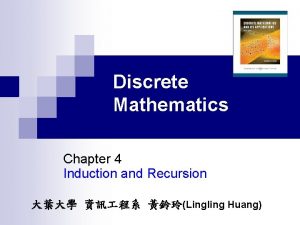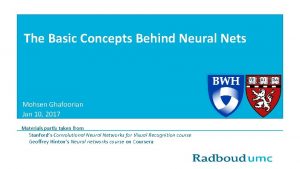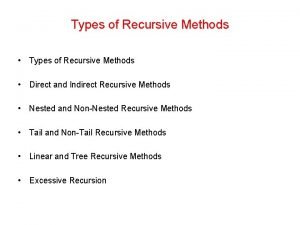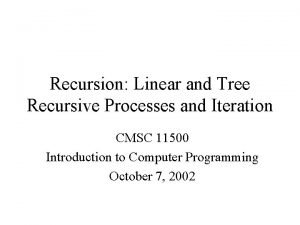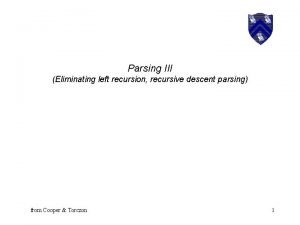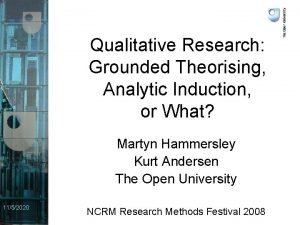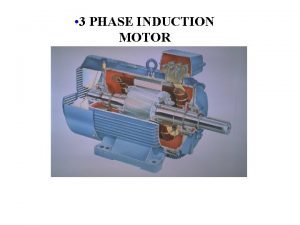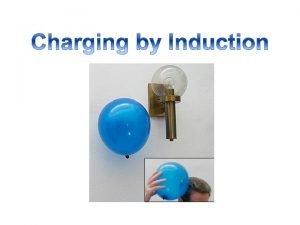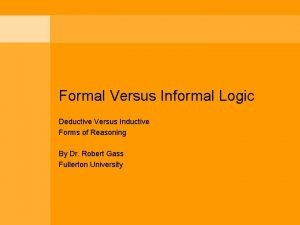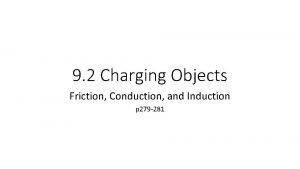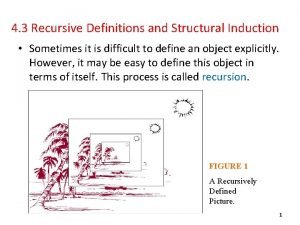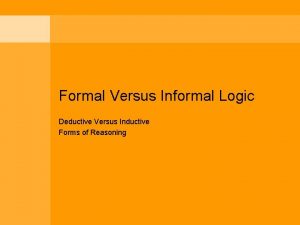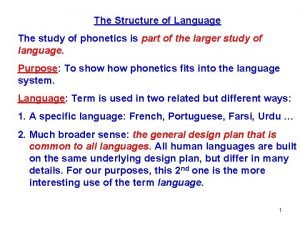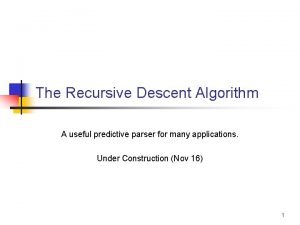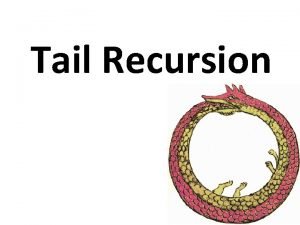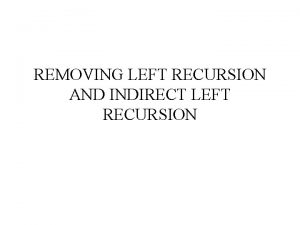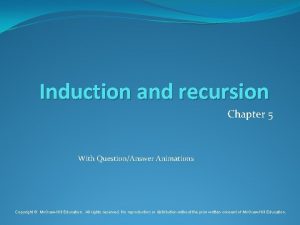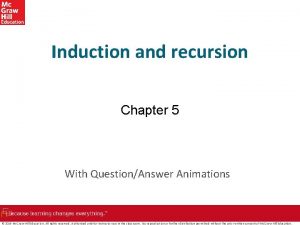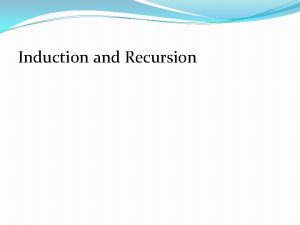Induction and recursion Chapter 5 With QuestionAnswer Animations
































- Slides: 32

Induction and recursion Chapter 5 With Question/Answer Animations 1

Chapter Summary �Mathematical Induction �Strong Induction �Well-Ordering �Recursive Definitions �Structural Induction �Recursive Algorithms �Program Correctness (not yet included in overheads) 2

Mathematical Induction Section 5. 1 3

Section Summary �Mathematical Induction �Examples of Proof by Mathematical Induction �Mistaken Proofs by Mathematical Induction �Guidelines for Proofs by Mathematical Induction 4

Climbing an Infinite Ladder Suppose we have an infinite ladder: 1. We can reach the first rung of the ladder. 2. If we can reach a particular rung of the ladder, then we can reach the next rung. From (1), we can reach the first rung. Then by applying (2), we can reach the second rung. Applying (2) again, the third rung. And so on. We can apply (2) any number of times to reach any particular rung, no matter how high up. This example motivates proof by mathematical induction. 5

Principle of Mathematical Induction: To prove that P(n) is true for all positive integers n, we complete these steps: � Basis Step: Show that P(1) is true. � Inductive Step: Show that P(k) → P(k + 1) is true for all positive integers k. To complete the inductive step, assuming the inductive hypothesis that P(k) holds for an arbitrary integer k, show that must P(k + 1) be true. Climbing an Infinite Ladder Example: � BASIS STEP: we can reach rung 1. � INDUCTIVE STEP: Assume the inductive hypothesis that we can reach rung k. Then, we can reach rung k + 1. Hence, P(k) → P(k + 1) is true for all positive integers k. We can reach every rung on the ladder. 6

Important Points About Using Mathematical Induction �Mathematical induction can be expressed as the rule of inference (P(1) ∧ ∀k (P(k) → P(k + 1))) → ∀n P(n), where the domain is the set of positive integers. �In a proof by mathematical induction, we do NOT assume that P(k) is true for all positive integers! We show that if we assume that P(k) is true, then P(k + 1) must also be true. �Proofs by mathematical induction do not always start at the integer 1. In such a case, the basis step begins at a starting point b where b is an integer. We will see examples of this soon. 7

Validity of Mathematical Induction � Mathematical induction is valid because of the well ordering property, which states that every nonempty subset of the set of positive integers has a least element (see Section 5. 2 and Appendix 1). Here is the proof: � Suppose that P(1) holds and P(k) → P(k + 1) is true for all positive integers k. � Assume there is at least one positive integer n for which P(n) is false. Then the set S of positive integers for which P(n) is false is nonempty. � By the well-ordering property, S has a least element, say m. � We know that m can not be 1 since P(1) holds. � Since m is positive and greater than 1, m − 1 must be a positive integer. Since m − 1 < m, it is not in S, so P(m − 1) must be true. � But then, since the conditional P(k) → P(k + 1) for every positive integer k holds, P(m) must also be true. This contradicts P(m) being false. � Hence, P(n) must be true for every positive integer n. 8

Remembering How Mathematical Induction Works Consider an infinite sequence of dominoes, labeled 1, 2, 3, …, where each domino is standing. Let P(n) be the proposition that the nth domino is knocked over. We know that the first domino is knocked down, i. e. , P(1) is true. We also know that if whenever the kth domino is knocked over, it knocks over the (k + 1)st domino, i. e, P(k) → P(k + 1) is true for all positive integers k. Hence, all dominos are knocked over. P(n) is true for all positive integers n. 9

Proving a Summation Formula by Mathematical Induction Example: Show that: Solution: i Note: Once we have this conjecture, mathematical induction can be used to prove it correct. �BASIS STEP: P(1) is true since 1(1 + 1)/2 = 1. �INDUCTIVE STEP: Assume P(k) true for arbitrary k>1. The inductive hypothesis is Under this assumption, 10

Conjecturing and Proving Correct a Summation Formula Example: Conjecture and prove correct a formula for the sum of the first n positive odd integers. Then prove your conjecture. Solution: We have: 1= 1, 1 + 3 = 4, 1 + 3 + 5 = 9, 1 + 3 + 5 + 7 = 16, 1 + 3 + 5 + 7 + 9 = 25. � We can conjecture that the sum of the first n positive odd integers is n 2, 1 + 3 + 5 + ∙∙∙+ (2 n − 1) + (2 n + 1) =n 2. � We prove the conjecture is proved correct with mathematical induction. � BASIS STEP: P(1) is true since 12 = 1. � INDUCTIVE STEP: P(k) → P(k + 1) for every positive integer k. Assume the inductive hypothesis holds and then show that P(k) holds has well. Inductive Hypothesis: 1 + 3 + 5 + ∙∙∙+ (2 k − 1) =k 2 � So, assuming P(k), it follows that: 1 + 3 + 5 + ∙∙∙+ (2 k − 1) + (2 k + 1) =[1 + 3 + 5 + ∙∙∙+ (2 k − 1)] + (2 k + 1) = k 2 + (2 k + 1) (by the inductive hypothesis) = k 2 + 2 k + 1 = (k + 1) 2 � Hence, we have shown that P(k + 1) follows from P(k). Therefore the sum of the first n positive odd integers is n 2. 11

Proving Inequalities Example: Use mathematical induction to prove that n < 2 n for all positive integers n. Solution: Let P(n) be the proposition that n < 2 n. �BASIS STEP: P(1) is true since 1 < 21 = 2. �INDUCTIVE STEP: Assume P(k) holds, i. e. , k < 2 k, for an arbitrary positive integer k. �Must show that P(k + 1) holds. Since by the inductive hypothesis, k < 2 k, it follows that: k + 1 < 2 k + 1 ≤ 2 k + 2 k = 2 ∙ 2 k = 2 k+1 Therefore n < 2 n holds for all positive integers n. 12

Proving Inequalities Example: Use mathematical induction to prove that 2 n < n!, for every integer n ≥ 4. Solution: Let P(n) be the proposition that 2 n < n!. �BASIS STEP: P(4) is true since 24 = 16 < 4! = 24. �INDUCTIVE STEP: Assume P(k) holds, i. e. , 2 k < k! for an arbitrary integer k ≥ 4. To show that P(k + 1) holds: 2 k+1 = 2∙ 2 k < 2∙ k! (by the inductive hypothesis) < (k + 1)k! = (k + 1)! Therefore, 2 n < n! holds, for every integer n ≥ 4. Note that here the basis step is P(4), since P(0), P(1), P(2), and P(3) are all false. 13

Proving Divisibility Results Example: Use mathematical induction to prove that n 3 − n is divisible by 3, for every positive integer n. Solution: Let P(n) be the proposition that n 3 − n is divisible by 3. � BASIS STEP: P(1) is true since 13 − 1 = 0, which is divisible by 3. � INDUCTIVE STEP: Assume P(k) holds, i. e. , k 3 − k is divisible by 3, for an arbitrary positive integer k. To show that P(k + 1) follows: (k + 1)3 − (k + 1) = (k 3 + 3 k 2 + 3 k + 1) − (k + 1) = (k 3 − k) + 3(k 2 + k) By the inductive hypothesis, the first term (k 3 − k) is divisible by 3 and the second term is divisible by 3 since it is an integer multiplied by 3. So by part (i) of Theorem 1 in Section 4. 1 , (k + 1)3 − (k + 1) is divisible by 3. Therefore, n 3 − n is divisible by 3, for every integer positive integer n. 14

Number of Subsets of a Finite Set Example: Use mathematical induction to show that if S is a finite set with n elements, where n is a nonnegative integer, then S has 2 n subsets. (Chapter 6 uses combinatorial methods to prove this result. ) Solution: Let P(n) be the proposition that a set with n elements has 2 n subsets. �Basis Step: P(0) is true, because the empty set has only itself as a subset and 20 = 1. �Inductive Step: Assume P(k) is true for an arbitrary nonnegative integer k. continued → 15

Number of Subsets of a Finite Set Inductive Hypothesis: For an arbitrary nonnegative integer k, every set with k elements has 2 k subsets. Let T be a set with k + 1 elements. Then T = S ∪ {a}, where a ∈ T and S = T − {a}. Hence |T| = k. � For each subset X of S, there are exactly two subsets of T, i. e. , X and X ∪ {a}. � � By the inductive hypothesis S has 2 k subsets. Since there are two subsets of T for each subset of S, the number of subsets of T is 2 ∙ 2 k = 2 k+1. 16

Tiling Checkerboards SS to Slide 20 Example: Show that every 2 n × 2 n checkerboard with one square removed can be tiled using right triominoes. A right triomino is an L-shaped tile which covers three squares at a time. Solution: Let P(n) be the proposition that every 2 n × 2 n checkerboard with one square removed can be tiled using right triominoes. Use mathematical induction to prove that P(n) is true for all positive integers n. � BASIS STEP: P(1) is true, because each of the four 2 × 2 checkerboards with one square removed can be tiled using one right triomino. � INDUCTIVE STEP: Assume that P(k) is true for every 2 k × 2 k checkerboard, for some positive integer k. continued → 17

Tiling Checkerboards SS to Slide 20 Inductive Hypothesis: Every 2 k × 2 k checkerboard, for some positive integer k, with one square removed can be tiled using right triominoes. � Consider a 2 k+1 × 2 k+1 checkerboard with one square removed. Split this checkerboard into four checkerboards of size 2 k × 2 k, by dividing it in half in both directions. � Remove a square from one of the four 2 k × 2 k checkerboards. By the inductive hypothesis, this board can be tiled. Also by the inductive hypothesis, the other three boards can be tiled with the square from the corner of the center of the original board removed. We can then cover the three adjacent squares with a triominoe. Hence, the entire 2 k+1 × 2 k+1 checkerboard with one square removed can be tiled using right triominoes. � 18

An Incorrect “Proof” by Mathematical Induction SS to Slide 20 Example: Let P(n) be the statement that every set of n lines in the plane, no two of which are parallel, meet in a common point. Here is a “proof” that P(n) is true for all positive integers n ≥ 2. � BASIS STEP: The statement P(2) is true because any two lines in the plane that are not parallel meet in a common point. � INDUCTIVE STEP: The inductive hypothesis is the statement that P(k) is true for the positive integer k ≥ 2, i. e. , every set of k lines in the plane, no two of which are parallel, meet in a common point. � We must show that if P(k) holds, then P(k + 1) holds, i. e. , if every set of k lines in the plane, no two of which are parallel, k ≥ 2, meet in a common point, then every set of k + 1 lines in the plane, no two of which are parallel, meet in a common point. continued → 19

An Incorrect “Proof” by Mathematical Induction SS to Slide 20 Inductive Hypothesis: Every set of k lines in the plane, where k ≥ 2, no two of which are parallel, meet in a common point. � Consider a set of k + 1 distinct lines in the plane, no two parallel. By the inductive hypothesis, the first k of these lines must meet in a common point p 1. By the inductive hypothesis, the last k of these lines meet in a common point p 2. � If p 1 and p 2 are different points, all lines containing both of them must be the same line since two points determine a line. This contradicts the assumption that the lines are distinct. Hence, p 1 = p 2 lies on all k + 1 distinct lines, and therefore P(k + 1) holds. Assuming that k ≥ 2, distinct lines meet in a common point, then every k + 1 lines meet in a common point. � There must be an error in this proof since the conclusion is absurd. But where is the error? � Answer: P(k)→ P(k + 1) only holds for k ≥ 3. It is not the case that P(2) implies P(3). The first two lines must meet in a common point p 1 and the second two must meet in a common point p 2. They do not have to be the same point since only the second line is common to both sets of lines. 20

Guidelines: Mathematical Induction Proofs 21

Strong Induction and Well -Ordering Section 5. 2 22

Section Summary �Strong Induction �Example Proofs using Strong Induction �Using Strong Induction in Computational Geometry (not yet included in overheads) �Well-Ordering Property 23

Strong Induction �Strong Induction: To prove that P(n) is true for all positive integers n, where P(n) is a propositional function, complete two steps: �Basis Step: Verify that the proposition P(1) is true. �Inductive Step: Show the conditional statement [P(1) ∧ P(2) ∧∙∙∙ ∧ P(k)] → P(k + 1) holds for all positive integers k. Strong Induction is sometimes called the second principle of mathematical induction or complete induction. 24

Strong Induction and the Infinite Ladder Strong induction tells us that we can reach all rungs if: 1. We can reach the first rung of the ladder. 2. For every integer k, if we can reach the first k rungs, then we can reach the (k + 1)st rung. To conclude that we can reach every rung by strong induction: • BASIS STEP: P(1) holds • INDUCTIVE STEP: Assume P(1) ∧ P(2) ∧∙∙∙ ∧ P(k) holds for an arbitrary integer k, and show that P(k + 1) must also hold. We will have then shown by strong induction that for every positive integer n, P(n) holds, i. e. , we can reach the nth rung of the ladder. 25

Proof using Strong Induction Example: Suppose we can reach the first and second rungs of an infinite ladder, and we know that if we can reach a rung, then we can reach two rungs higher. Prove that we can reach every rung. (Try this with mathematical induction. ) Solution: Prove the result using strong induction. �BASIS STEP: We can reach the first step. �INDUCTIVE STEP: The inductive hypothesis is that we can reach the first k rungs, for any k ≥ 2. We can reach the (k + 1)st rung since we can reach the (k − 1)st rung by the inductive hypothesis. �Hence, we can reach all rungs of the ladder. 26

Which Form of Induction Should Be Used? �We can always use strong induction instead of mathematical induction. But there is no reason to use it if it is simpler to use mathematical induction. (See page 335 of text. ) �In fact, the principles of mathematical induction, strong induction, and the well-ordering property are all equivalent. (Exercises 41 -43) �Sometimes it is clear how to proceed using one of the three methods, but not the other two. 27

Completion of the proof of the Fundamental Theorem of Arithmetic Example: Show that if n is an integer greater than 1, then n can be written as the product of primes. Solution: Let P(n) be the proposition that n can be written as a product of primes. � BASIS STEP: P(2) is true since 2 itself is prime. � INDUCTIVE STEP: The inductive hypothesis is P(j) is true for all integers j with 2 ≤ j ≤ k. To show that P(k + 1) must be true under this assumption, two cases need to be considered: � � If k + 1 is prime, then P(k + 1) is true. Otherwise, k + 1 is composite and can be written as the product of two positive integers a and b with 2 ≤ a ≤ b < k + 1. By the inductive hypothesis a and b can be written as the product of primes and therefore k + 1 can also be written as the product of those primes. Hence, it has been shown that every integer greater than 1 can be written as the product of primes. (uniqueness proved in Section 4. 3) 28

Proof using Strong Induction Example: Prove that every amount of postage of 12 cents or more can be formed using just 4 -cent and 5 -cent stamps. Solution: Let P(n) be the proposition that postage of n cents can be formed using 4 -cent and 5 -cent stamps. � BASIS STEP: P(12), P(13), P(14), and P(15) hold. � P(12) uses three 4 -cent stamps. � P(13) uses two 4 -cent stamps and one 5 -cent stamp. � P(14) uses one 4 -cent stamp and two 5 -cent stamps. � P(15) uses three 5 -cent stamps. � INDUCTIVE STEP: The inductive hypothesis states that P(j) holds for 12 ≤ j ≤ k, where k ≥ 15. Assuming the inductive hypothesis, it can be shown that P(k + 1) holds. � Using the inductive hypothesis, P(k − 3) holds since k − 3 ≥ 12. To form postage of k + 1 cents, add a 4 -cent stamp to the postage for k − 3 cents. Hence, P(n) holds for all n ≥ 12. 29

Proof of Same Example using Mathematical Induction Example: Prove that every amount of postage of 12 cents or more can be formed using just 4 -cent and 5 -cent stamps. Solution: Let P(n) be the proposition that postage of n cents can be formed using 4 -cent and 5 -cent stamps. � BASIS STEP: Postage of 12 cents can be formed using three 4 -cent stamps. � INDUCTIVE STEP: The inductive hypothesis P(k) for any positive integer k is that postage of k cents can be formed using 4 -cent and 5 -cent stamps. To show P(k + 1) where k ≥ 12 , we consider two cases: � � If at least one 4 -cent stamp has been used, then a 4 -cent stamp can be replaced with a 5 -cent stamp to yield a total of k + 1 cents. Otherwise, no 4 -cent stamp have been used and at least three 5 -cent stamps were used. Three 5 -cent stamps can be replaced by four 4 -cent stamps to yield a total of k + 1 cents. Hence, P(n) holds for all n ≥ 12. 30

Well-Ordering Property �Well-ordering property: Every nonempty set of nonnegative integers has a least element. �The well-ordering property is one of the axioms of the positive integers listed in Appendix 1. �The well-ordering property can be used directly in proofs, as the next example illustrates. �The well-ordering property can be generalized. �Definition: A set is well ordered if every subset has a least element. N is well ordered under ≤. � The set of finite strings over an alphabet using lexicographic ordering is well ordered. � �We will see a generalization of induction to sets other than the integers in the next section. 31

Well-Ordering Property Example: Use the well-ordering property to prove the division algorithm, which states that if a is an integer and d is a positive integer, then there are unique integers q and r with 0 ≤ r < d, such that a = dq + r. Solution: Let S be the set of nonnegative integers of the form a − dq, where q is an integer. The set is nonempty since −dq can be made as large as needed. − 2 r = a − dq 0. The integer r is nonnegative. It also must be the case that r < d. If it were not, then there would be a smaller nonnegative element in S, namely, a − d(q 0 + 1) = a − dq 0 − d = r − d > 0. �Therefore, there are integers q and r with 0 ≤ r < d. . �By the well-ordering property, S has a least element (uniqueness of q and r is Exercise 37) 32
 Induction and recursion discrete mathematics
Induction and recursion discrete mathematics To understand recursion you must understand recursion
To understand recursion you must understand recursion Animasi multimedia
Animasi multimedia Impulse-style scroll animations
Impulse-style scroll animations Pcr gif animation
Pcr gif animation Google photos create animation
Google photos create animation Loffe animations
Loffe animations Animation frame unit
Animation frame unit Recruitment selection and induction policies and procedures
Recruitment selection and induction policies and procedures Mamdm
Mamdm Iterative vs recursive
Iterative vs recursive Using functions in models and decision making
Using functions in models and decision making Indirect recursion
Indirect recursion Similarities between iteration and recursion
Similarities between iteration and recursion Linear and tree recursion
Linear and tree recursion Recursive descent parser left recursion
Recursive descent parser left recursion Analytic induction and grounded theory
Analytic induction and grounded theory Explication and induction
Explication and induction 3-phase induction motor problems and solutions
3-phase induction motor problems and solutions Deduction and induction
Deduction and induction Environmental induction training ppt
Environmental induction training ppt Is charging by induction temporary or permanent
Is charging by induction temporary or permanent Induction vs deduction
Induction vs deduction Charging by conduction
Charging by conduction Induction and competence
Induction and competence Recursive definitions and structural induction
Recursive definitions and structural induction Induction vs deduction
Induction vs deduction Difference between induction heating and dielectric heating
Difference between induction heating and dielectric heating Vba recursion
Vba recursion Recursion in language
Recursion in language Eliminate left recursion calculator
Eliminate left recursion calculator Tail recursion
Tail recursion Immediate left recursive
Immediate left recursive
